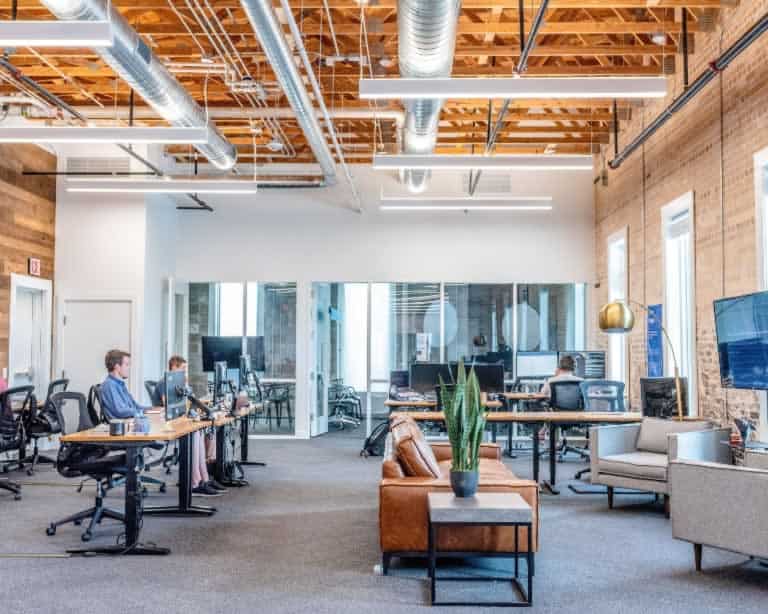The COVID-19 pandemic has forced us to take a long, hard look at some things we used to take for granted. Over the past year, we’ve embraced measures for personal protection against the virus, communities have come together to help those in need, businesses have pivoted their marketing strategies, and so much more.
We’ve also learned that our employees can work productively and efficiently, even when everyone on the team is working from a home office. While the coronavirus didn’t start the shift away from the traditional office and towards remote work, it certainly sped things up:
- In 2018, 16% of the American workforce worked from home
- In 2020, 42% of the American workforce worked from home
The dramatic and sudden shift towards remote work has led many businesses to take a close look at the way they will do business in a post-pandemic world – including considerations around 🏢 office 🏢 space.
Specifically (and inevitably) many businesses are asking a fundamental question about office space: Have we had an office because it’s actually necessary to do business or have we had an office because it’s the way things have always been.

Given that technology collapses boundaries and eliminates distance, it’s a great question that's been forced on us by tragic circumstances.
And now that the end of the current pandemic is finally on the horizon, is it time to start thinking long-term about downsizing office space or even letting it go entirely by joining the growing ranks of fully remote companies?
Is Remote Work Working?
Before considering downsizing or ditching the office permanently, you have to consider the way the shift to a remote workforce has affected your business.
Do you know, for instance, how the productivity of your staff working from home compares to when they were working in your office?
According to research by Global Workplace Analytics in the late 2000s, businesses were losing $600 billion annually due to workplace distractions.
That same study says that many companies like Best Buy and Dow Chemical report that remote workers are 35-40% more productive than on-site workers.
With meetings moved to online 📹 conferencing platforms like Zoom, discussions tend to be more focused and on-topic than in-person meetings. There’s also the added benefit of being able to record an online meeting, so meetings can start and finish on time, and late-arrivals and no-shows can get caught up at their convenience.
And since there’s no commute, many employees have more time to actually get work done. This is particularly true for people in professions like sales, where commuting to and from off-site meetings with clients would consume a significant portion of their days.
Of course, a lot depends on the nature of your work and your company culture.
In a highly collaborative workplace – the type where employees are encouraged to bounce new ideas off of each other and innovate as a team – an increase in productivity could, for example, come at the expense of creativity.
If any such trade-offs are too potentially harmful to the needs of your business, then you’d need to find ways to minimize the adverse effects.
What Does Your Workforce Want?
Here’s a sobering statistic: nearly 30% of working remote employees say they would quit their jobs if they had to give up remote work and go back to working in the office “after the pandemic.“

With so much of the workforce now accustomed to working from home – and, in the process, perhaps enjoying a greater work-life balance – it seems that the idea of going back to the way things were before the pandemic carries some risk.
Could you afford to take a chance on possibly losing nearly a third of your workforce by making everyone give up remote work and return to the office when it’s safe to do so?
Still, working from home can be difficult for some employees – especially those with “built-in distractions” like roommates or small children (or Netflix 😂).
And then there are others who enjoy the social aspects of working in an office. After all, making friends is one of the “perks” that come with having a job and working with other people.
And we can’t overlook the fact that some people do better in a supervised office setting because it helps to keep them accountable.
The best way to determine your workforce’s preferences around remote work vs. office work is to simply ask them. If you have a small team, you can simply gather together over a Zoom meeting and talk about the best way forward.
If you have a large team, you could collect feedback with an online survey.
Ultimately, you’re going to have to be prepared for the fact that people will fall into one of three camps:
- Those that want to continue to do remote work
- Those that want to return to the office full time
- Those that want to combine remote work with office work
Of course, after you’ve gathered and analyzed the feedback, you’re going to make decisions on how you’ll be able to accommodate the needs of your workforce, without sacrificing productivity.
Is There a Happy Medium Between Remote Work & Office Work?
Perhaps the ultimate solution will lie somewhere in between full-time work at the office and full-time remote jobs. A flexible working environment allows employees to make their own decisions about where they’ll work, as long as they continue to perform their jobs well and are capable of completing their tasks from home.

This type of arrangement means companies can maintain smaller office space for those employees who prefer to work onsite (plus a conference room for important meetings). You could also set up “coworking spaces” within the office, so remote workers would have a table to sit at if they needed or wished to work from the office for the day.
With less space needed for offices or cubicles, you could significantly downsize your square footage without erasing your company’s office presence.
For many businesses, a flexible schedule also creates an opportunity for people to work at atypical business hours.
So instead of simply setting out a traditional 9 – 5 ⏲️ schedule, you could consider setting up different schedules, depending on business needs and employee preferences – e.g.,
- Early worms – start at 5 or 6 AM (or earlier)
- Late risers – start at 10 or 11 AM (or later)
If business needs dictate there’s a period where full capacity is necessary, you could organize the schedule so there is an overlap for an “all ✋✋✋ on deck” period.
Not only would this address the needs and preferences of your current team, but it could also help improve customer service – giving customers access to employees working outside of traditional office hours – and even stand as a potential perk for job seekers.
If you do shift away from a full-time office model, try to integrate some “not lame” team-building activities into the work week or month, so your employees still get some face time with you and their coworkers.
The Future of Office Work
We’re living and working at an unprecedented time in the business world. And it's forcing us to reconsider some of the fundamentals about the way we work. For the first time, with remote work being the new norm, location truly isn’t a barrier to an office job. A transition that could have taken a decade or more has been sped up by necessity due to the pandemic.
It will be fascinating to see what office work looks like in the years to come!
Tagged with:
